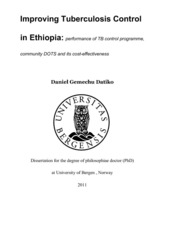| dc.contributor.author | Datiko, Daniel Gemechu | en_US |
| dc.date.accessioned | 2011-02-22T13:56:03Z | |
| dc.date.available | 2011-02-22T13:56:03Z | |
| dc.date.issued | 2011-02-04 | eng |
| dc.identifier.isbn | 978-82-308-1693-6 (print version) | en_US |
| dc.identifier.uri | https://hdl.handle.net/1956/4523 | |
| dc.description.abstract | World Health Organization (WHO) recommends directly observed treatment short course (DOTS) strategy to control tuberculosis (TB). It aims to detect 70% of new smear-positive cases and cure 85% of them. Implementing the DOTS strategy has improved the case detection rate (CDR) and treatment success rate (TSR) in many settings. We reviewed the performance of TB control programme of the southern Ethiopia. Low CDR mainly because of inability to access the health service was the limit. We also explored alternatives that could improve access to the health service, its costeffectiveness; estimated the recurrence rate and mortality in successfully treated TB patients under DOTS strategy and the rate of human immunodeficiency virus (HIV) infection in TB patients. In ten years, TB control programme of southern Ethiopia has improved the case detection (from 22% to 45%) and treatment success (from 53% to 85%). However, the target of CDR seemed unachievable. Some of the reasons were low health service coverage, shortage of general health workers (GHWs), HIV epidemic and poor socioeconomic conditions. Ethiopia launched community-based programme that deployed huge number of health extension workers (HEWs) to the community. Nevertheless, the possible contribution of HEWs in TB control programme of Ethiopia has not been explored. We, therefore, employed community-based approach to identify alternatives that improve the performance of TB control programme. The HEWs were involved in sputum collection and providing directly observed treatment (DOT). This improved the CDR, more significantly for women. This could be mainly because of the community-based sputum collection that had increased access to the diagnostic service. Moreover, community-based treatment improved the TSR of smear-positive patients (90%) compared with to health facility-based DOT (83%). This could be due to the improved access to the service that was created through the provision of DOT in the community where TB patients live, with in reachable distance. The decision to employ effective interventions by policy-and decision-makers depends on the available resources and existing supporting evidences. This is more important in resource-constrained settings with high disease burden. We, therefore, estimated the cost and cost-effectiveness of involving HEWs in providing DOT. In our study, treating smear-positive cases in the community reduced the total, patient and caregiver costs by 62.6%, 63.9% and 88.2%, respectively. We also estimated the recurrence rate and mortality in TB patients cured under DOTS strategy and the rate of HIV infection in TB patients and the community. The rate of recurrence in smear-positive TB patients cured under DOTS strategy was 1 per 100 PYO (0.01 per annum). The rate of TB-HIV co-infection varied with the prevalence of HIV in the community. We found mortality rate of 2.5% per annum in successfully treated TB patients. The mortality was associated with sex, age and occupation. We have shown that the performance of TB control programme could be improved by involving HEWs in TB control programme as we found improved the CDR and TSR. Community-based DOT is economically attractive option to the patient, the household and the health service. We recommend planned scaling up and implementation of community-based TB care in Ethiopia to improve the performance of National TB Leprosy Control Programme (NTLCP). Currently the Federal Ministry of Health of Ethiopia has accepted and endorsed the implementation of community-based TB care by involving HEWs. National guideline for implementing community-based TB care is being developed to apply it at larger-scale in Ethiopia. | en_US |
| dc.language.iso | eng | eng |
| dc.publisher | The University of Bergen | eng |
| dc.relation.haspart | Paper I: International Journal of Tuberculosis and Lung Disease 10(10), Yassin, M. A.; Datiko, D. G.; Shargie, E. B., Ten-year experiences of the tuberculosis control programme in the southern region of Ethiopia, pp. 1166-1171. Copyright 2006 International Union Against Tuberculosis and Lung Disease. Full text not available in BORA due to publisher restrictions. | en_US |
| dc.relation.haspart | Paper II: BMC Public Health 8(266), Datiko, D. G.; Yassin, M. A.; Chekol, L. T.; Kabeto, L. E.; Lindtjørn, B., The rate of TB-HIV co-infection depends on the prevalence of HIV infection in a community. Copyright 2008 Datiko et al; licensee BioMed Central. Reproduced with permission. Published version. The published version is also available at: <a href="http://dx.doi.org/10.1186/1471-2458-8-266" target="_blank"> http://dx.doi.org/10.1186/1471-2458-8-266</a> | en_US |
| dc.relation.haspart | Paper III: PLoS ONE 4(5), Datiko, D. G.; Lindtjørn, B., Health Extension Workers Improve Tuberculosis Case Detection and Treatment Success in Southern Ethiopia: A Community Randomized Trial, e5443. Copyright 2009 Datiko, Lindtjørn. Reproduced with permission. Published version. The published version is also available at: <a href="http://dx.doi.org/10.1371/journal.pone.0005443" target="_blank"> http://dx.doi.org/10.1371/journal.pone.0005443</a> | en_US |
| dc.relation.haspart | Paper IV: PLoS ONE 5(2), Datiko, D. G.; Lindtjørn, B., Cost and Cost-Effectiveness of Treating Smear-Positive Tuberculosis by Health Extension Workers in Ethiopia: An Ancillary Cost-Effectiveness Analysis of Community Randomized Trial, e9158. Copyright 2010 Datiko, Lindtjørn. Reproduced with permission. Published version. The published version is also available at: <a href="http://dx.doi.org/10.1371/journal.pone.0009158" target="_blank"> http://dx.doi.org/10.1371/journal.pone.0009158</a> | en_US |
| dc.relation.haspart | Paper V: BMC Public Health 9(266), Datiko, D. G.; Lindtjørn, B., Tuberculosis recurrence in smear-positive patients cured under DOTS in southern Ethiopia: retrospective cohort study. Copyright 2009 Datiko and Lindtjørn; licensee BioMed Central. Reproduced with permission. Published version. The published version is also available at: <a href="http://dx.doi.org/10.1186/1471-2458-9-348" target="_blank">http://dx.doi.org/10.1186/1471-2458-9-348</a> | en_US |
| dc.relation.haspart | Paper VI: International Journal of Tuberculosis and Lung Disease 14(7), Datiko, D. G.; Lindtjørn, B., Mortality in successfully treated tuberculosis patients in southern Ethiopia: retrospective follow-up study, pp. 866-871. Copyright 2006 International Union Against Tuberculosis and Lung Disease. Full text not available in BORA due to publisher restrictions. | en_US |
| dc.title | Improving Tuberculosis Control in Ethiopia: performance of TB control programme, community DOTS and its cost-effectiveness | en_US |
| dc.type | Doctoral thesis | |
| dc.rights.holder | Copyright the author. All rights reserved | |
| dc.rights.holder | The author | |
| dc.subject.nsi | VDP::Medical disciplines: 700::Clinical medical disciplines: 750::Lung diseases: 777 | eng |





